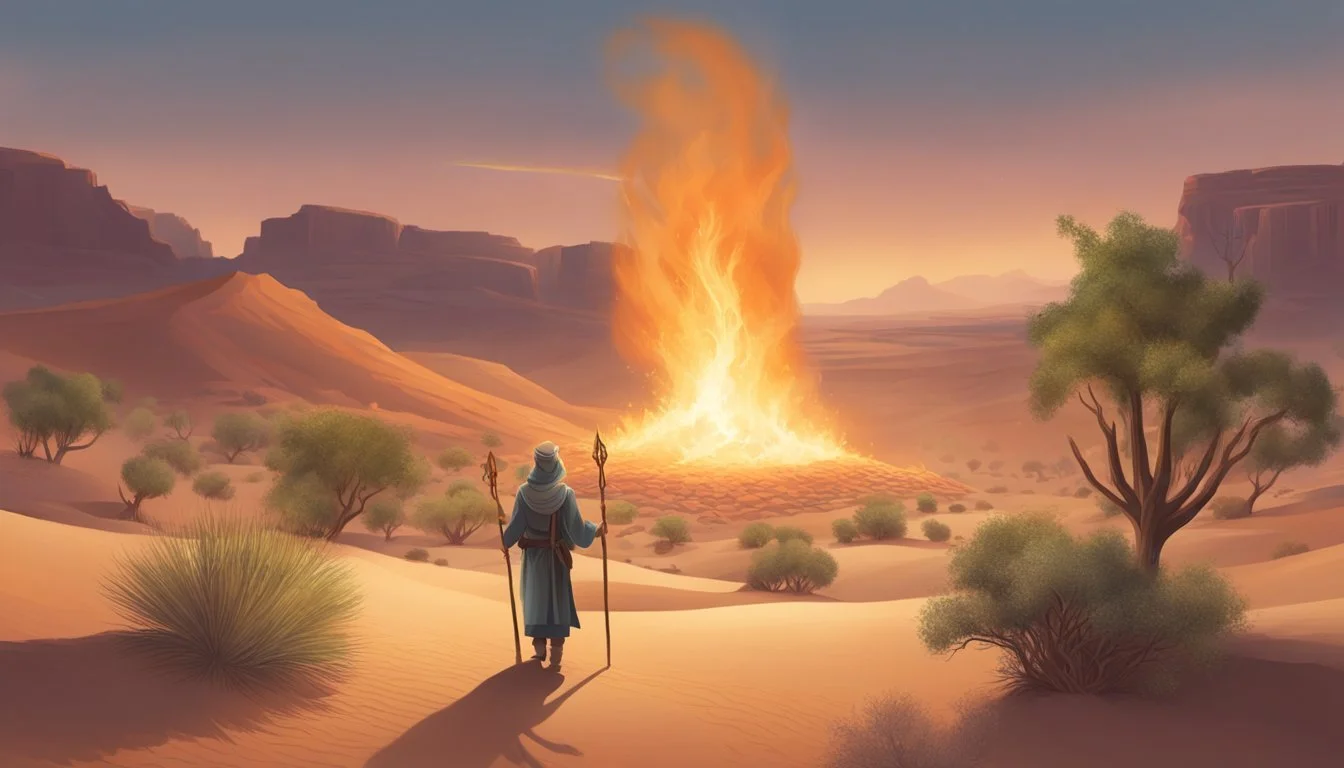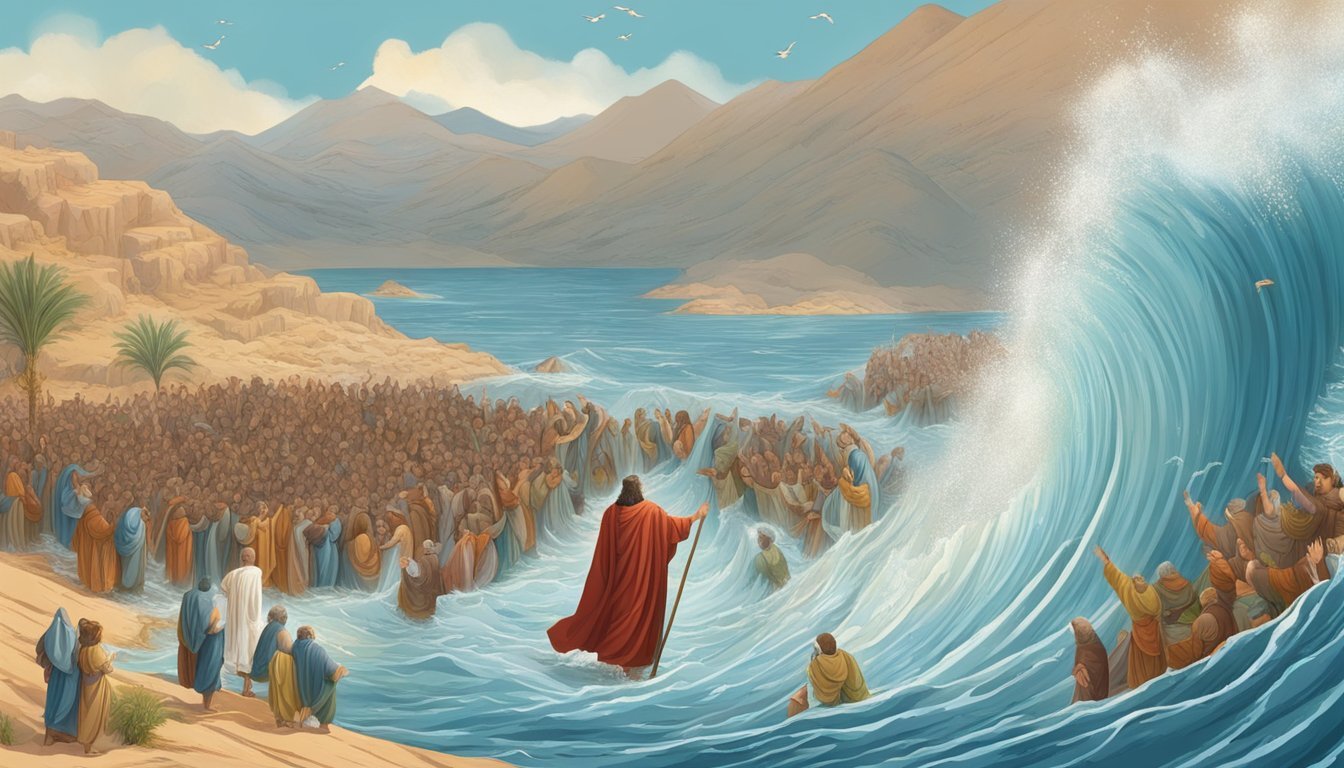Easter Eggs and Hidden Details in 'Testament: The Story of Moses'
Unveiling Biblical Secrets
Netflix's "Testament: The Story of Moses" offers a fresh take on the iconic biblical figure, blending documentary-style interviews with dramatic reenactments. This unique docudrama format allows viewers to explore Moses' journey from outcast to prophet in a new light. The series reveals hidden details and nuances often overlooked in traditional retellings, providing deeper insights into Moses' character and the Exodus story.
Sharp-eyed viewers can spot several Easter eggs and subtle nods to biblical scholarship throughout the three-part series. From carefully chosen set designs to historically accurate costumes, the production team has woven in numerous details for attentive audiences to discover. These hidden gems serve to enrich the viewing experience and encourage further exploration of the biblical narrative.
Genesis of 'Testament: The Story of Moses'
'Testament: The Story of Moses' emerged as Netflix's ambitious foray into biblical storytelling. The three-part docudrama aims to present a fresh perspective on the iconic Exodus narrative.
At its core, the series explores Moses' journey from exile to liberator. It delves into the personal struggles and inner life of this central figure in Abrahamic religions.
The production team sought to humanize Moses, moving beyond the superhuman portrayal often seen in traditional retellings. This approach allows viewers to connect more deeply with the character's experiences.
Narrated by Charles Dance, the series blends dramatized scenes with documentary-style elements. This format helps bridge the gap between historical context and storytelling.
The creators drew inspiration from various sources, including the Old Testament and archaeological findings. Their goal was to present a nuanced view of Moses' life and the Exodus story.
'Testament' quickly gained popularity upon release. In its first five days, the show amassed 13.5 million views, rivaling the global Jewish population in viewership numbers.
This success demonstrates a continued interest in biblical narratives, particularly when presented through a contemporary lens. The series joins a long tradition of Moses-themed productions, offering its unique take on this timeless tale.
Moses' Life and Legacy
Moses stands as a pivotal figure in religious history, shaping the beliefs and practices of Judaism, Christianity, and Islam. His journey from prince to prophet transformed the Hebrews and left an enduring impact on world religions.
Early Years and Royal Upbringing
Born to Hebrew slaves in Egypt, Moses was saved from Pharaoh's decree by his mother's ingenuity. Placed in a basket on the Nile, he was discovered and adopted by Pharaoh's daughter. Moses grew up in the royal court, educated in Egyptian wisdom and culture.
His privileged upbringing contrasted sharply with the plight of his people. This dichotomy would shape his future role as a leader and liberator.
Call to Prophet and Revelations
Moses' life changed dramatically when he encountered God at the burning bush. This divine revelation marked his call to prophethood and set in motion the events that would define his legacy.
God tasked Moses with freeing the Hebrews from Egyptian bondage. Despite initial reluctance, Moses accepted this mission, armed with miraculous signs to convince both Pharaoh and his own people.
Leadership and Exodus
Moses' leadership was tested as he confronted Pharaoh, demanding freedom for the Hebrews. The plagues that followed demonstrated divine power and ultimately led to the Exodus.
Guiding the Israelites through the wilderness, Moses faced numerous challenges. He provided water from rocks, manna from heaven, and leadership during times of doubt and rebellion.
The parting of the Red Sea remains one of the most iconic moments in Moses' story, symbolizing divine intervention and the journey to freedom.
Ten Commandments and Covenant
At Mount Sinai, Moses received the Ten Commandments, establishing a covenant between God and the Israelites. These laws formed the foundation of Hebrew religious and social life.
Moses' role as mediator between God and the people was crucial during this period. He conveyed divine instructions for worship, social conduct, and governance.
The golden calf incident tested Moses' leadership. His intercession on behalf of the people showcased his compassion and dedication to their welfare.
Death and Eternal Influence
Moses led the Israelites to the edge of the Promised Land but was not permitted to enter. He died atop Mount Nebo, having glimpsed the land he had journeyed so long to reach.
His influence extends far beyond his lifetime. Moses is revered in Judaism as the greatest prophet, in Christianity as a precursor to Jesus, and in Islam as an important messenger of God.
The story of Moses continues to inspire faith, courage, and the pursuit of freedom. His life serves as a testament to the power of conviction and the enduring impact of divine calling.
Cinematic Approach and Filmmaking
"Testament: The Story of Moses" blends cinematic reenactments with expert interviews, creating a unique visual and narrative experience. This approach allows for both dramatic storytelling and scholarly insights.
Visual Storytelling Techniques
The series employs striking cinematography to bring the ancient world to life. Sweeping landscape shots capture the grandeur of Egypt and the Sinai desert. Close-ups of actors' faces convey the emotional intensity of key moments in Moses' journey.
Director Emre Sahin uses lighting to dramatic effect. Scenes set in Pharaoh's palace are bathed in golden hues, contrasting with the harsh sunlight of the desert sequences. Slow-motion shots emphasize pivotal events like the parting of the Red Sea.
The series also incorporates subtle visual metaphors. As Moses grows into his role as a leader, his posture and gait change subtly over time.
Recreating Historical Authenticity
Meticulous attention to detail brings the ancient world to life. Costume designers researched period-appropriate fabrics and styles for both Egyptian and Hebrew characters. Set designers drew inspiration from archaeological findings to recreate authentic living spaces and architecture.
The series consulted Egyptologists to ensure accuracy in depicting hieroglyphs and religious rituals. Props such as tools, weapons, and household items were crafted based on historical artifacts.
Special effects were used sparingly to maintain a sense of realism. When depicting miracles, the filmmakers aimed for a grounded approach that leaves room for interpretation.
Integrating Scholarly Insights
"Testament" seamlessly weaves expert commentary into the narrative. Historians, theologians, and religious scholars from Jewish, Christian, and Muslim backgrounds offer context and analysis throughout the series.
These interviews provide multiple perspectives on key events and themes in Moses' life. Experts discuss the historical context of slavery in ancient Egypt and the significance of the Exodus in different faith traditions.
The series also explores recent archaeological findings related to the biblical narrative. This integration of scholarship adds depth to the storytelling, encouraging viewers to engage critically with the material.
Theological and Historical Analysis
The portrayal of Moses in "Testament: The Story of Moses" prompts deeper examination of his theological significance and historical context. Scholars, theologians, and historians offer varying perspectives on the biblical figure's life and impact.
Scholarly Commentary
Biblical scholars analyze the Moses narrative through multiple lenses. Some focus on the literary structure of the Exodus account, noting its dramatic elements and symbolic imagery. Others examine archaeological evidence related to the time period, seeking correlations with biblical descriptions.
Egyptologists debate potential historical figures who may have inspired the Moses story. Some point to figures like Akhenaten or Ramesses II as possible influences. However, conclusive archaeological proof remains elusive.
Theologians emphasize Moses' role as a prophet and lawgiver. They explore his encounters with God and the significance of the Ten Commandments in shaping Judeo-Christian ethics.
Biblical vs. Historical Narratives
The biblical account of Moses differs from strictly historical narratives. While the Bible presents Moses as a central figure in Israel's formation, secular historians approach the story more cautiously.
Some scholars argue for a historical core to the Exodus narrative, suggesting it may reflect memories of Semitic groups leaving Egypt. Others view it as primarily theological literature, meant to convey religious truths rather than historical facts.
Debates continue over the plausibility of events like the parting of the Red Sea. Some researchers propose natural explanations, while others maintain the miraculous nature of the account.
Interpretations of Moses' Character
Religious leaders often present Moses as an exemplar of faith and leadership. They highlight his humility, courage, and dedication to God's will.
Psychological interpretations examine Moses' inner conflicts, such as his initial reluctance to lead and his struggles with anger. These analyses aim to make Moses more relatable to modern audiences.
Some scholars focus on Moses' role as a cultural hero, embodying ideals of liberation and justice. They explore how different faith traditions and cultures have adapted the Moses story to their own contexts.
Historians debate Moses' influence on the development of monotheism and written law. While some credit him with revolutionary religious innovations, others see his role as part of a longer evolutionary process in Near Eastern religion.
Iconic Scenes and Set Pieces
"Testament: The Story of Moses" features several pivotal moments that have become iconic in biblical storytelling. These key scenes showcase the epic scale and divine interventions central to the Exodus narrative.
Depiction of the Red Sea Crossing
The Red Sea crossing stands as one of the most visually striking scenes in the film. As the Israelites flee Egypt, they find themselves trapped between Pharaoh's army and the sea. Moses raises his staff, and the waters part, creating towering walls on either side. The freed slaves walk on dry ground between the massive liquid barriers.
Special effects bring this miracle to life, with computer-generated imagery enhancing practical sets. The camera pans across the awestruck faces of the Israelites as they witness this act of divine intervention. The scene culminates in a dramatic collapse of the waters upon the pursuing Egyptian forces.
Revelation at Mount Sinai
Mount Sinai serves as the backdrop for Moses' encounter with God. The film portrays this pivotal moment with a mix of natural grandeur and supernatural elements. Thunder and lightning accompany Moses' ascent up the mountain, shrouded in smoke and fire.
The revelation scene employs unique sound design to represent the voice of God. Visual effects create the appearance of divine writing on stone tablets. The movie emphasizes the contrast between the solitary figure of Moses on the mountain and the anxious Israelites waiting below.
Golden Calf Incident
The Golden Calf episode illustrates the Israelites' loss of faith during Moses' absence. The film depicts the growing unrest among the people, leading to the creation of the idol. Aaron's reluctant participation adds complexity to the scene.
The return of Moses is portrayed with dramatic intensity. His anger upon seeing the idol worship is palpable. The destruction of the Golden Calf and the tablets of the law provides a visually powerful moment. This scene underscores the themes of faith, doubt, and divine judgment central to the Exodus story.
Hidden Details and Easter Eggs
"Testament: The Story of Moses" is rich with subtle nods to biblical lore, historical events, and symbolism. Careful viewers will spot numerous references woven throughout the film's narrative and visual elements.
Symbolic Motifs
The burning bush serves as a recurring motif, appearing subtly in various scenes. Eagle-eyed viewers might notice flame-like patterns in fabrics or architectural designs, echoing this pivotal moment in Moses' life. Water also plays a symbolic role, representing both destruction and salvation. The filmmakers cleverly incorporate water imagery in unexpected places, such as reflections or subtle background elements.
The staff of Moses undergoes a visual transformation throughout the film. Its appearance changes subtly to reflect Moses' journey from shepherd to prophet. The staff's engravings evolve, incorporating Egyptian and Hebrew symbols as the story progresses.
Biblical References
"Testament" includes numerous nods to lesser-known biblical accounts. Attentive viewers might spot references to the Midrash, rabbinical commentaries on Hebrew scriptures. These appear as brief dialogue exchanges or visual cues that enrich the narrative for those familiar with these texts.
The film incorporates accurate depictions of ancient Egyptian deities in background scenes. These subtle inclusions provide historical context and highlight the polytheistic culture Moses confronts. Each plague scene contains hidden references to specific verses from Exodus, often represented through visual metaphors or background details.
Historical Retellings
The filmmakers meticulously researched ancient Egyptian and Hebrew cultures to include authentic details. Hieroglyphs visible in palace scenes contain actual historical information relevant to the time period. Costumes and set designs feature historically accurate patterns and materials, with each tribe's attire subtly differentiated.
Archaeological discoveries influenced certain scenes. Keen observers might recognize references to specific artifacts or architectural elements uncovered in recent excavations. The depiction of the Exodus route incorporates geological evidence, with landscape details hinting at theories about the actual path taken by the Israelites.
Cultural Impact and Reception
"Testament: The Story of Moses" has sparked discussions across various segments of society. The series has drawn attention for its unique approach to portraying the biblical figure and its incorporation of diverse religious perspectives.
Mainstream Media
Major news outlets have covered the series extensively. The show's rise to Netflix's top rankings has garnered significant media attention. Critics have praised the docudrama's blend of historical reenactments and expert commentary. Some reviewers have compared it favorably to "The Prince of Egypt," noting its more grounded approach to the Moses narrative.
The three-part series format has been highlighted as an effective way to present the complex story. Media coverage has often focused on the show's use of extra-biblical Jewish texts to enrich the storytelling.
Religious Communities
Jewish, Christian, and Muslim leaders have offered varied responses to the series. Many religious figures have appreciated the show's effort to include multiple faith perspectives. Some Jewish commentators have praised the incorporation of midrashic material, viewing it as a respectful nod to Jewish tradition.
Christian leaders have generally responded positively to the portrayal of Moses as a relatable human figure. Muslim clerics have noted the series' acknowledgment of Moses' importance in Islamic tradition. However, some conservative religious voices have expressed concerns about potential deviations from sacred texts.
Academic Circles
Scholars in religious studies, history, and archaeology have engaged with the series. Many academics have commended the show's attempt to balance dramatization with historical context. The inclusion of expert commentary from various fields has been seen as adding depth to the narrative.
Some historians have debated the accuracy of certain portrayals, particularly regarding ancient Egyptian culture. Archaeological experts have discussed how the series aligns with or differs from current understanding of the time period. The show has sparked renewed academic interest in comparative religious studies, focusing on shared narratives across Abrahamic faiths.
Engagement and Educational Value
Testament: The Story of Moses offers a blend of dramatic reenactments and scholarly commentary. This approach enhances viewer engagement by bringing the biblical narrative to life visually.
The series features expert insights on Moses, Aaron, Miriam, and Zipporah. These commentaries provide historical and cultural context, enriching the educational experience.
Netflix's docuseries format allows for a deeper exploration of the subject matter. Viewers can pause, rewind, and rewatch segments to absorb complex information at their own pace.
The show's production values contribute to its educational impact. High-quality visuals and costumes help immerse viewers in the ancient world of Moses and the Exodus.
Testament balances entertainment with factual content. This combination makes it accessible to a wide audience, from casual viewers to those seeking more in-depth knowledge.
By presenting multiple perspectives on the Moses story, the series encourages critical thinking. It invites viewers to consider different interpretations of historical and religious events.





